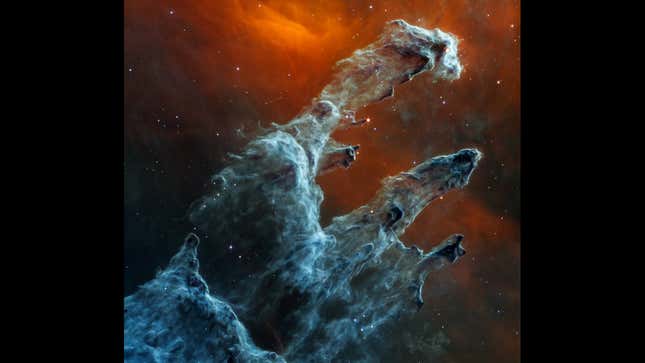
A week and a half ago, NASA released a stunning image of the iconic Pillars of Creation taken by the Webb Space Telescope, a $10 billion state-of-the-art space observatory that launched last December.
Now, the space agency has shared a shot of the same structure taken with Webb’s Mid-Infrared Instrument (MIRI). It’s a perfectly terrifying image to release days before Halloween.
The Pillars of Creation are huge structures made of gas and dust that form one arm of the Eagle Nebula, a cluster of stars about 6,500 light-years from Earth.
The pillars themselves are about five light-years long (meaning if you were standing on the tip of one of the pillars, it would take about five years to see light arrive from the other end). And for the reference of terrestrial travelers, one light year is about 5.88 trillion miles.
The first Webb image of the pillars was taken with the Near-Infrared Camera (NIRCam), meaning it collects light in the near-infrared portion of the electromagnetic spectrum. The image revealed countless stars not seen in the famous image of the pillars taken by the Hubble Space Telescope in 1995. Hubble images primarily in optical and ultraviolet light, so what it sees is very different from what Webb sees.

The new image strictly looks at mid-infrared light. Though newly published, Webb actually took the image on August 14; it takes time to sift through all the image data and translate the wavelengths into a sensible range of visible light for our viewing pleasure.
In the haunting image, the stars disappear almost entirely. The columns of gas and dust—an inviting rusty orange in the NIRCam image—become a haunting pale blue. Meanwhile, the cooler dust in the top right of the image becomes pumpkin orange.
Webb’s first look at the Pillars calls to mind the hand of man (or God) in Michelangelo’s The Creation of Adam. In MIRI’s eye, the gassy pillars are more evocative of a zombie’s undead fingers reaching out for a victim.
Mid-infrared images by Webb are great for revealing gas and dust. As the Space Telescope Science Institute explains it, “The stars at the end of the thick, dusty pillars have recently eroded the material surrounding them. They show up in red because their atmospheres are still enshrouded in cloaks of dust. In contrast, blue tones indicate stars that are older and have shed most of their gas and dust.”
In September, MIRI cut through interstellar dust to see the gossamer strands of the Tarantula Nebula, and it was used in conjunction with NIRCam to produce the telescope’s first awesome images.
Somewhat counterintuitively, darker regions in the bottom left corner of the image are actually whether the densest, coolest accumulations of the stuff resides.
Webb kicked off its image production on July 12 and is expected to be in operation for at least a decade. The telescope’s precise launch means it could be in operation for up to 20 years, though, if we’re lucky. If you want to know what Webb is up to at any given moment, there’s a Twitter bot that’ll keep you up-to-date.